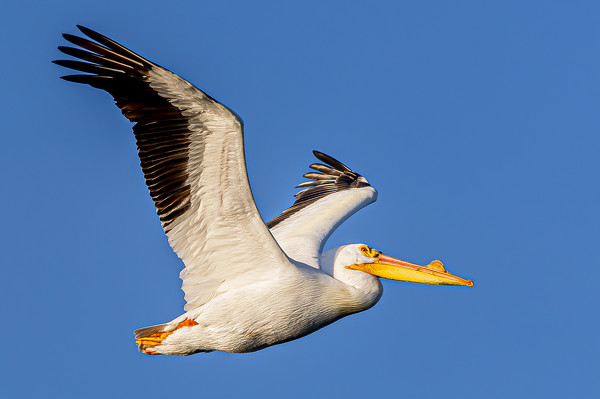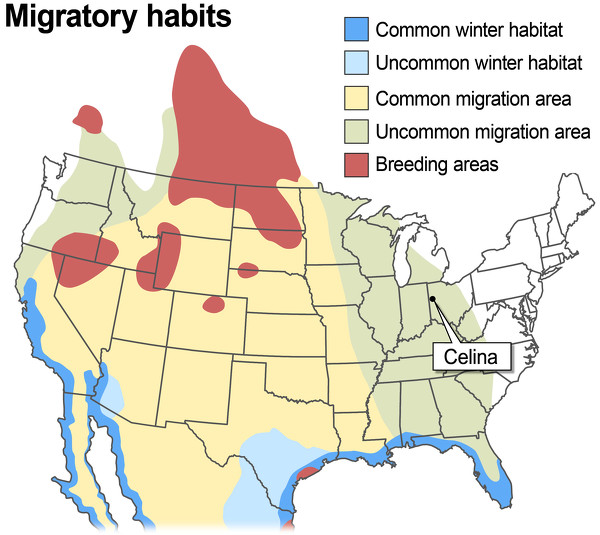
American white pelicans preen on some rocks on Grand Lake. The bird in the center has its bill sac inside out. Randy Bennett photo.
Every year the swallows return to Mission San Juan Capistrano, California, and the buzzards fly back to Hinkley.
On Grand Lake, the pelicans return.
This year the first flocks of the freshwater, inland birds arrived in late February.
"It was extraordinarily early this year," Celina wildlife photographer Randy Bennett said. "I was at the Mercer Wildlife Area and another photographer was there and I saw a flock of snow geese - they're black and white - but they weren't snow geese. They were pelicans, about 16 of them."
The Friends of Grand Lake Facebook page has been packed with photos of American white pelicans since then, including some shot by Bennett.

An American white pelican soars over Grand Lake. Ken Bigham photo.
American white pelicans, one of the largest birds by weight in North America with a 9-foot wingspan, started coming to the lake in larger numbers - groups of 40 or more - during spring and fall migrations about seven years ago. The first Grand Lake sighting the newspaper recorded in recent years was in 2009 when a pair was spotted. Every year since, their numbers have grown.
Last summer Celina resident Josh King spotted a squadron of more than 600 at the wildlife area along state Route 703, a state record if it is certified.
A large group stayed on the lake all last summer and did not migrate. Some immature pelicans were spotted later last summer, leading some observers to wonder if the birds had nested on Grand Lake - that is hatched eggs and reared young. This would be the first reported nesting for the 13,500-acre manmade lake.
Brett Beatty, wildlife management supervisor for the Ohio Division of Wildlife District 5, said he saw no evidence that pelicans had nested on Grand Lake last summer but didn't rule out the possibility completely.
"It could be the juvenile birds people saw were working their way back south from the northern prairie potholes," Beatty said. "Is it possible (they nested last summer)? Sure. But there is no way to know every nook and cranny of the lake."

This map shows the American white pelican migratory habits.
Beatty said American white pelicans predominantly breed in the so-called pothole region of the northern Great Plains, which is marked by numerous wet prairie and wetland areas. The region is located in the Dakotas, parts of Montana and in Saskatchewan and Alberta in Canada.
Ken Bigham, Celina, said he has found the best times and locations to spot the birds are at sunrise and about an hour before sunset at Windy Point on the south side of the lake.
"The best thing to do is go out to Windy Point and put your head on a swivel," said Bigham, who also photographs the pelicans and other wildlife around the lake.
Bigham remembers the excitement of seeing them up close for the first time.
"You don't get this perspective of speed until they close in on you," he said. "When they get close to you, you realize that's an 8- or 9-foot wingspan," he said.
Bigham said he marvels at how such a large, heavy bird can get up enough speed to take off from the water. According to the U.S. Fish and Wildlife Service, they weigh between 10 and 20 pounds and can have a wingspan up to 91/2 feet.
As recently as Saturday, Bigham spotted a group of about 150 feeding at Villa Nova beach in Auglaize County, the first time he had seen any there.
"They were doing cooperative fishing where they would move in one direction, all working together to steer the fish," he said.
The publication "The Birds of Lake St. Marys," first printed in the 1940s and updated in 2001, noted the lake was a good place for American white pelicans dating back to the 19th and 20th centuries, said Jim McCormac, a birder, botanist, writer and wildlife photographer from Columbus. Until the early 2000s, no more than a few had been seen in Ohio in one place, but their numbers have skyrocketed since then, he said.

An American white pelican soars like a B-52 bomber over Grand Lake. Randy Bennett photo.
Many people are stunned when they see them because they believed the creatures are ocean birds. Brown pelicans are the type most often seen on the ocean, he said.
The birds have been spotted at other nearby canal lakes such as Indian Lake in Logan County and Lake Loramie in Auglaize and Shelby counties. Lake Erie also has seen larger flocks in recent years, McCormac said.
The birds have not been documented nesting in Ohio, yet. The closest they have gotten was a small island in Canada on Lake Erie a few years ago, he said. Their nesting range has been moving farther east, putting them closer to Grand Lake for migration stopovers to rest and feed, he said.
McCormac said it is possible they could nest on Grand Lake. In fact, he said he believes the pelicans' ancestors may have frequented the area before the lake existed. It was handmade between 1837 and 1845 to supply water to the Miami-Erie Canal. Before the lake was built, the area was a vast, wet prairie, perfect pelican-breeding habitat.
"When they were common, (Grand Lake) was a common place for them. It goes back to the late 1800s for pelicans on Grand Lake. This is one of the first places in Ohio documented to have them," he said for a previous article.
• With a weight between 10 and 20 pounds and a 9-foot wingspan, the white pelican is one of the largest birds in North America. Only the California condor has a broader wingspan.
• Pelicans scoop fish in their bill sacs while swimming. The bill sac can hold as much as 3 gallons of water.
• They fish as a group, forming a line to herd fish into shallow water near the shore.
• Both sexes grow a flat horn on their upper bill during the mating season each spring. The horn eventually falls off.
• The only place near Grand Lake that draws migratory pelicans in larger numbers is Goose Pond near Indianapolis.
• Protected under the Migratory Bird Treaty Act.